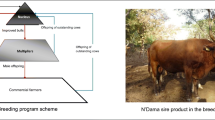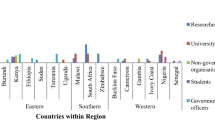Abstract
Animal recording in Kenya is characterised by erratic producer participation and high drop-out rates from the national recording scheme. This study evaluates factors influencing efficiency of beef and dairy cattle recording system. Factors influencing efficiency of animal identification and registration, pedigree and performance recording, and genetic evaluation and information utilisation were generated using qualitative and participatory methods. Pairwise comparison of factors was done by strengths, weaknesses, opportunities and threats–analytical hierarchical process analysis and priority scores to determine their relative importance to the system calculated using Eigenvalue method. For identification and registration, and evaluation and information utilisation, external factors had high priority scores. For pedigree and performance recording, threats and weaknesses had the highest priority scores. Strengths factors could not sustain the required efficiency of the system. Weaknesses of the system predisposed it to threats. Available opportunities could be explored as interventions to restore efficiency in the system. Defensive strategies such as reorienting the system to offer utility benefits to recording, forming symbiotic and binding collaboration between recording organisations and NARS, and development of institutions to support recording were feasible.

Similar content being viewed by others
References
Ahuya, C. O., Okeyo, A. M., Mwangi, N., Peacock, C., 2005. Development challenges and opportunities in the goat industry: the Kenya experience, Small Ruminant Research, 60, 197–206.
Bailey, D., 2004. Benefits and costs associated with an animal identification system for cattle in the United States, Western extension marketing committee, Animal Identification fact sheet No. 2. http://www.lmic.info/memberspublic/animalID/AnimalID.htm.
Caja, G., Ghirardi, J. J., Hernández-Jover, M., Garín, D., 2004. Diversity of animal identification techniques: from ‘fire age’ to ‘electronic age’. In: Pauw, R. Mack, S., Maki-Hokkonen, J. (Eds), Development of Animal Identification and Recording Systems for Developing Countries, ICAR Technical Series 9, 21–39.
Campher, J. P., 2004. Animal identification and recording systems in the Southern African Development Community (SADC): 1. Overview of the current situation. In: Pauw, R., Mack, S., Maki-Hokkonen, J. (Eds), Development of Animal Identification and Recording Systems for Developing Countries, ICAR Technical Series 9, 65–76.
Cermak, V., 2001. Breeder associations, milk recording and identification of cattle and sheep in the Czech Republic. In: Vares, T., Habe, F., Klopcic M. and Kompan, D. (Eds), Workshop on role of breeders' organisations and state in animal identification and recording in CEE countries, ICAR Technical Series 5, 53–60.
Department of Agriculture, 2000. Draft animal improvement policy for South Africa, http://www.nda.agric.za/docs/Animal_Improvement.pdf. Accessed on 17th, September 2008.
Dong, Y., Xu, Y., Li, H., Dai, M., 2008. A comparative study of the numerical scales and the prioritization methods in AHP, European Journal of Operational Research, 186, 229–242.
Expert Choice, 2008. http://www.expertchoice.com/products-services/expert-choice-115/.
Food and Agricultural Organisation (FAO), 1998. Secondary guidelines for development of national farm animal genetic resources management plans: animal recording for medium input production environment, Food and Agricultural Organization of the United Nations (FAO), Rome.
Flamant, J. C., 1998. The impact of socio-economic aspects on the development and outcome of animal recording systems. In: Trivedi, K. R. (Ed), International workshop on animal recording for smallholders in developing countries, ICAR Technical Series 1, 267–318.
Groen, A. F., 2000. Breeding goal definition. In: Galal, S., Boyazoglu, J., Hammond, K. (Eds), Developing breeding strategies for lower input animal production environments, ICAR Technical Series 3, 25–104.
Habe, F., Klopcic, M., Kavcic, S., Drobnic, M., Osterc, J., Cepon, M., Kompan, D, Golc, T., Erjavec, E., 2001. Breeder associations, milk recording and identification of cattle and sheep in Slovenia. In: Vares, T., Habe, F., Klopcic M., Kompan, D. (Eds), Workshop on role of breeders' organisations and state in animal identification and recording in CEE countries, ICAR Technical Series 5, 65–77.
Ho, W., 2008. Integrated analytic hierarchy process and its applications—A literature review, European Journal of Operational Research, 186, 211–228.
ICAR, 2007. International agreement of recording practices: ICAR recording guidelines, ICAR, Rome.
Kahi, A. K., Nitter, G., Gall, C. F., 2004. Developing breeding schemes for pasture based dairy production systems in Kenya II. Evaluation of alternative objectives and schemes using a two-tier open nucleus and young bull system, Livestock Production Science, 88, 179–192.
Kajanus, M., Kangas, J., Kurttila, M., 2004. The use of value focused thinking and the A’WOT hybrid method in tourism management, Tourism Management, 25, 499–506
Kosgey I. S., Okeyo, A. M., 2007. Genetic improvement of small ruminants in low-input, smallholder production systems: technical and infrastructural issues, Small Ruminants Research, 70, 76–88
Kosgey, I. S., Baker, R. L., Udo, H. M. J., Van Arendonk, J. A. M., 2006. Successes and failures of small ruminant breeding programmes in the tropics: a review, Small Ruminants Research, 61, 13–28.
Krencik, D., Kossowski, Z., 2001. The role of the state and breeder associations in animal identification and animal recording in Poland. In: Vares, T., Habe, F., Klopcic, M., Kompan, D. (Eds), Workshop on role of breeders' organisations and state in animal identification and recording in CEE countries, ICAR Technical Series 5, 87–92.
Kurttila, M., Pesonen, M., Kangas, J., Kajanus, M., 2000. Utilizing the analytic hierarchy process (AHP) in SWOT analysis- a hybrid method and its application to a forest-certification case, Forest Policy and Economics, 1, 41–52.
Masozera, M. K., Alavalapati, J. R. R., Jacobsonc, S. K., Shrestha, R. K., 2006. Assessing the suitability of community-based management for the Nyungwe Forest Reserve, Rwanda, Forest Policy and Economics, 8, 206–216
Mukisira, E. A., 1998. Dairy recording in Kenya. In: Trivedi, K. R. (Ed), International workshop on animal recording for smallholders in developing countries, ICAR Technical Series 1, 147–153.
Parra-López C, Calatrava-Requena J, de-Haro-Giménez T (2008) A systemic comparative assessment of the multifunctional performance of alternative olive systems in Spain within an AHP-extended framework. Ecological Economics 64:820–834
Pauw, R., Mack, S., Maki-Hokkonen, J. (Eds), 2004. Development of animal identification and recording systems for developing countries, ICAR Technical Series 9, ICAR, Rome.
Rewe, T. O., Indetie, D., Ojango, J. M. K., Kahi, A. K., 2006. Breeding objectives for the Boran breed in Kenya: model development and application to pasture-based production systems, Animal Science Journal, 77, 163–177.
Roberts, M., O’Brien, D., 2004. Animal Identification: confidentiality of information, Western extension marketing committee, Animal Identification fact sheet No. 5. http://www.lmic.info/memberspublic/animalID/AnimalID.htm.
Saaty, T. L., 1977. A scaling method for priorities in hierarchical structures, Journal of Mathematical Psychology, 15, 234- 281.
Saaty, T. L., 2006. Rank from comparisons and from ratings in the analytic hierarchy/network processes, European Journal of Operational Research, 168, 557–570.
Schmitt, F., Schild, H. J., 2004. Consultant’s view on successful planning of I and R. In: Pauw, R. Mack, S., Maki-Hokkonen, J. (Eds), Development of Animal Identification and Recording Systems for Developing Countries, ICAR Technical Series 9, 55–63.
Shrestha, R. K., Alavalapati, J. R. R., Kalmbacher, R. S., 2004. Exploring the potential for silvopasture adoption in south-central Florida: an application of SWOT–AHP method, Agricultural Systems, 81, 185–199.
South Africa Studbook and Animal Improvement Association, 2007. Stud breeders’ manual, Picasso Headline (Pty) Ltd, Cape Town.
Tonsor, G. T., Schroeder, T. C., 2006. Lessons for the US beef industry learned from the Australian National Livestock Identification System, Western extension marketing committee, Animal Identification fact sheet No. 13. http://www.lmic.info/memberspublic/animalID/AnimalID.htm.
Vares, T., Habe, F., Klopcic M., Kompan, D. (Eds), 2001. Workshop on role of breeders' organisations and state in animal identification and recording in CEE countries, ICAR Technical Series 5, ICAR, Rome.
Wasike, C. B., Indetie, D., Ojango, J. M. K., Kahi, A. K., 2009. Direct and maternal (co)variance components and genetic parameters for growth and reproductive traits in the Boran cattle in Kenya, Tropical Animal Health and Production 41, 741–748.
Wismans, W., Akkerman, T. M., 2001. Identification and registration of cattle: a challenge for breeding organizations. In: Vares, T., Habe, F., Klopcic M. and Kompan, D. (Eds), Workshop on role of breeders' organisations and state in animal identification and recording in CEE countries, ICAR Technical Series 5, 41–51.
Author information
Authors and Affiliations
Corresponding author
Rights and permissions
About this article
Cite this article
Wasike, C.B., Magothe, T.M., Kahi, A.K. et al. Factors that influence the efficiency of beef and dairy cattle recording system in Kenya: A SWOT–AHP analysis. Trop Anim Health Prod 43, 141–152 (2011). https://doi.org/10.1007/s11250-010-9666-3
Accepted:
Published:
Issue Date:
DOI: https://doi.org/10.1007/s11250-010-9666-3




